|
Jeep
|
1941 - Present |
Country: |
 |
|
'JEEP – THE TOUGHEST WORD ON FOUR WHEELS' was an advertising slogan which aptly summed up the reputation of one of the most famous vehicles ever built. After the end of World War 1, it was accepted that the internal-combustion engine would take the place of the horse (except it seems in France, where the reliance on the horse showed the folly of such thinking in 1940). The American military command therefore began to look for a small, light vehicle to fill a number of holes.
The Quartermaster Corps
This vehicle had to be light and capable of being manhandled by a few men, the silhouette had to be low enough to escape detection, and it had to have the capacity to haul heavy infantry weapons to the firing line. Evaluation of such a project came under the Quartermaster Corps and several bodies concerned with the development of transport in the US Army.
Tests were made on several versions of commercial trucks fitted with half-track conversions. Although these experiments led to other interesting developments in military transport, they showed that the truck was the wrong vehicle for the task. Instead, it was suggested that a light-car would be more suitable.
The Ford Model-T is Chosen
There were only a few car producers to choose from in the early twenties and of the selection a
Ford Model T was chosen. For a car called on to fulfil a military role, it was superb, however it kept getting stuck in mud and sand. By fitting high-flotation tyres, the problem was overcome, and it is conceivable that the Model T could have become the standard light military 'workhorse" had it not been for the fitting of special equipment demanded by certain arms of the service; the advantage of the T's light weight was lost, together with its manoeuvrability.
It was not until 1932 that the next step in the development towards the Jeep was positively reached. One of the relevant boards saddled with the problem, had heard that the British Army had been experimenting with an Austin light-car, with much the same purpose in mind, The American Austin Company, which bore no similarity except in name to its British counterpart, supplied one of these cars to the US Army for test.
The American Bantam Company
Four years later, in 1936, American Austin changed its name and became the American Bantam Company. This was a significant change, as it was Bantam who set the ball rolling for the basic development of the four-wheel-drive Jeep. In a separate sphere of automotive engineering, the Marmon-Herrington Company of Indianapolis, who made all-wheel-drive trucks, were looking toward the Military as potential customers. The all-wheel drive of the MH trucks was obtained by the conversion of the front axle to a driving axle; in those days, this was a novelty. Both the US and the Belgium governments of the day expressed great interest in the MH trucks.
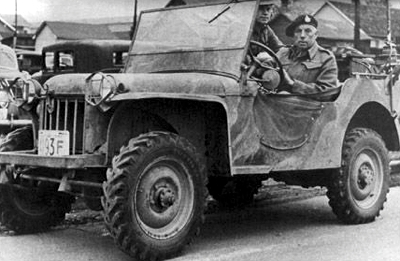 1941 Bantam Jeep.
1941 Bantam Jeep.
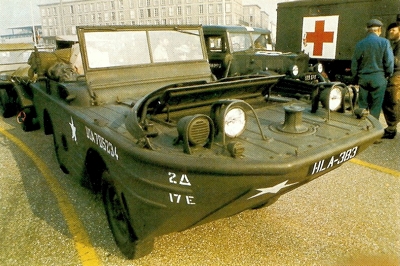 The GPA Water Jeep was not as successful as hoped. Being 1000 lb. heavier than the standard Jeep, it could travel at up to 7 knots in the water. Only 12,000 were manufactured.
The GPA Water Jeep was not as successful as hoped. Being 1000 lb. heavier than the standard Jeep, it could travel at up to 7 knots in the water. Only 12,000 were manufactured.
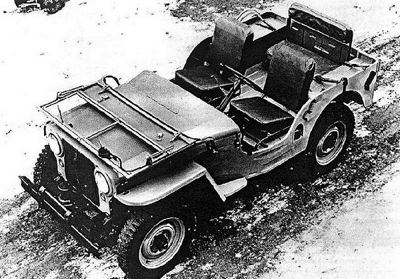 Willy's Jeep.
Willy's Jeep.
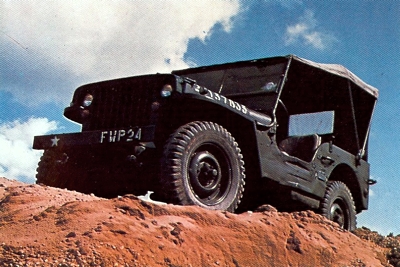 1942 Willy's Jeep.
1942 Willy's Jeep.
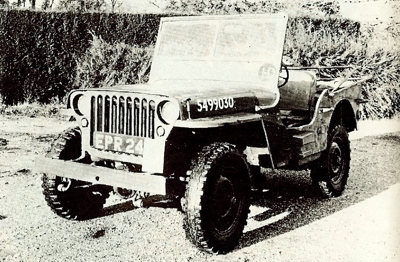 1943 Willy's Jeep.
1943 Willy's Jeep.
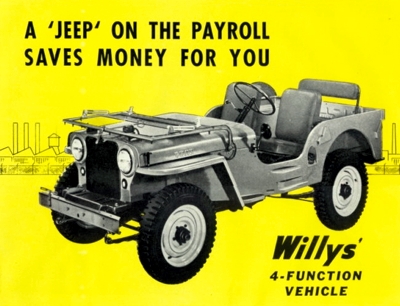 Willy's Jeep.
Willy's Jeep.
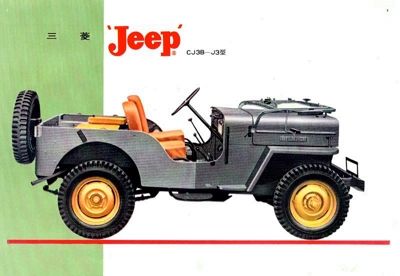 The Mitsubishi Jeep.
The Mitsubishi Jeep.
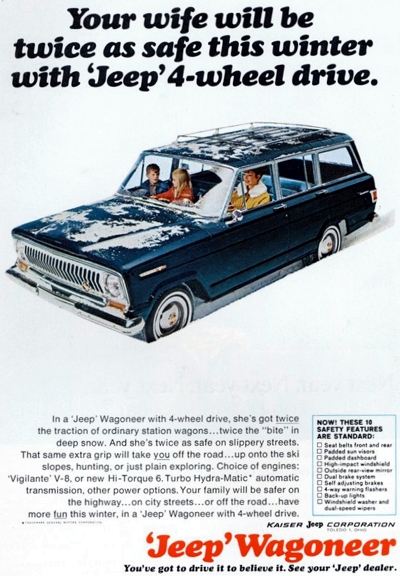 Jeep Wagoneer.
Jeep Wagoneer.
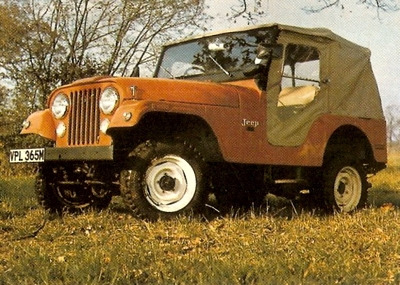 1974 CJ5 Short Wheelbase Jeep, which remained a direct descendent of the original.
1974 CJ5 Short Wheelbase Jeep, which remained a direct descendent of the original.
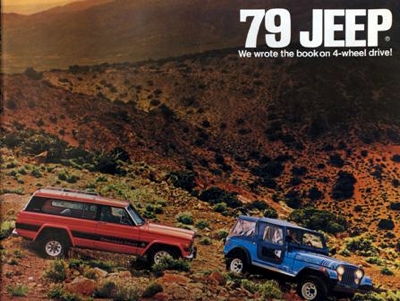 By 1979 the Jeep catch cry had changed to "We wrote the book on 4-wheel drive".
By 1979 the Jeep catch cry had changed to "We wrote the book on 4-wheel drive". |
Captain R. G. Howie and Sergeant M. C Wiley
Such a leisurely search for the ideal vehicle had prompted some Army officers to forge ahead on their own project for a likely vehicle. One such individual was Captain R. G. Howie who, with Sergeant M. C Wiley, built the Howie-Wiley machine-gun carrier. This vehicle was built in spare time, with many of the parts reclaimed from the junk heap. Finance for the venture, what little there was, came from the regimental bookshop funds! The sparse machine-gun carrier was quite devoid of any springs and had only its front axle driven, from an engine mounted at the rear. The crew of two, with a .30 calibre machine gun, lay in a prone position.
Delmar Roos
Although the carrier had no four-wheel drive, the height was low and it was a step in the right direction. This was confirmed by Delmar Roos, Chief Engineer of Willys-Overland, one of the manufacturers whose cars had been evaluated from time to time. The American Bantam Company had loaned the Army three cars, and the Army was impressed with their performance. Howie and the committee visited the Bantam factory and, after a satisfactory inspection, decided to go ahead and build a 'light reconnaissance and command' car with a simple rectangular body, front-wheel drive with a two-speed transfer case, a folding windscreen, and a .30 calibre machine-gun mount.
Karl K. Probst
Invitations to construct such a vehicle were put out to 135 manufacturers, including Bantam and Willys-Overland; this tender was to build seventy models. There was a certain amount of controversy, however, when the Bantam Company was awarded the contract, due to their prior knowledge of the project. In the incredibly short time of only two months, the first Bantam was completed, an engineer by the name. of Karl K. Probst being responsible for the design and the construction.
500 Jeeps Each from Bantam, Ford and Willys
The first Bantam arrived at the Holabird test ground just half an hour before the first deadline, the little truck being driven down to run it in. The Bantam fared well in the tests, but the design was now the property of the Army. Both Ford and Willys-Overland had been watching the tests and when they produced their pilot models they were similar to the Bantam. The Bantams which had been delivered were such a success that the Quartermaster Corps ordered another 1500 vehicles, not all from Bantam, but split three ways between Bantam, Ford and Willys.
The Bantam, Pygmy, and Quad
The Army argued that as there were three models, one might prove itself better than the others; also, such an order would be completed in a third of the time. The end result, hastened by America's preparation to enter World War 2, coupled with the lease-lend agreements with the Allied powers, called for a standardisation of the 1-ton 4 x 4 range. The best points from the Bantam, the Ford Pygmy, and the Willys Quad, as they were called, were all combined in one model, first called the MA and then standardised as the MB which became the standard Jeep.
By this time, the 'Jeep' had become the vehicle's unofficially accepted name. It seems probable that the term was used by the soldiers who were testing the early pilot models: because it could do almost anything, the vehicle was likened to the comic cartoon animal, 'Jeep', who appeared with Popeye, the sailor. 'Jeep' had supernatural powers and could do the impossible. The technicians who worked with the early Jeeps liked the name and used it regularly, so it stayed. It is also suggested that the designation GPW, the model code of the Ford-built jeeps, may have had something to do with the name: Gee Pee-Jeep.
Bantam Denied Production Rights
Willys won the first major Jeep order by giving the lowest unit price; the order was then given to Ford who guaranteed that there would be no delay in their production. Later, the order was withdrawn and given back to Willys. In the end, Ford built the bulk of wartime Jeeps because of their vast mass-production facilities. Bantam was squeezed out, denied any production rights at all, although it had pioneered the design and the concept for a light 4 x 4.
Over 635,000 MBs were built. 131 ins long and weighing 24531bs, the MB could haul 1000 lbs, and often pulled more. The Willys L-head engine developed 60 bhp and put out 105lb ft torque at 2000 rpm. In short, it was tough, manoeuvrable and fast. It would go almost anywhere and do almost anything. Because of its reputation, the standardised MB became subjected to conversions, like armour-plating it, most of which only slowed it down, and made it near useless.
A Reuptation Is Built
Apart from being the workhorse of the Allied armies, the Jeep completed some extraordinary operations. In North Africa, the British used their Jeeps to tremendous effect against the enemy. Loaded with extra fuel, water and munitions, flying columns of the Special Air Service Regiment ventured into the desert for weeks on end to harry the Axis. In the island-hopping amphibious war in the Pacific, the Jeep was running supply convoys along bulldozed tracks from the coral sand beaches to the mud-slimed jungle front line.
Jeep ambulances, often with field-improvised litter platforms, scurried through enemy territory and no-man's land in an effort to evacuate wounded tu the forward aid stations. Still in the East, the Jeep was fitted with flanged wheels and raced through the jungle along the railway lines. The Jeeps hauled trains, delivered the mail, carried the Generals, and were delivered by air; they fought their way through sand, snow, mud and water, finding a place in people's hearts for relieving the load on their war-battered lives.
The GPA / Amphib
Even at an early stage in Jeep development, it had been thought that an amphibious version of the Jeep would be ideal. The development of the GPA, or Amphib, is another sad tale of a large company taking the prized contract.
Marmon-Herrington developed a pilot model of the Amphib with the New York boat builder Sparkman and Stephens. Ford again snapped up the GPA contract because of their facilities. The GPA was not as successful as it should have been, although 12,000 were eventually built.
Willys-Overland Register The Jeep Name
The performance of the GPA was much the same as the MB, even though it weighed 1000 lbs more. Its power, for water operations, was taken to the propeller via a transfer-ease-mounted power take-off; it could achieve about 7 knots (roughly 8 miles per hour) in this way.
No MBs were made after 1945, Willys-Overland registered the name Jeep then, and later, in 1953, changed the company name to Willys Motors Inc. They were mindful of the advantage of receiving the wartime contracts and, recognising the benefit of the self-generative success of the Jeep, began to produce civilian versions, designated CJ.
The 2A was the first and was built from 1945 to 1949; it was virtually an MB with larger headlamps and a tailgate. 100,000 were built, of which a quarter went for export. The 2A was followed by the 3A produced until 1953. This was still based on the MB, but had several detail changes, such as a one-piece windscreen, a semi-floating rear axle, a strengthened differential and transfer-gear case. No military version of a Jeep had been built since the end of the war, and the MBs were still in service. Lack of funds for a new military model brought the interim M38.
The Jeepney
In the Phillipines, a unique type of taxi named the Jeepney was created in the Philippines. The first Jeepneys were military-surplus MB and GPWs, left behind in the war-ravaged country following WWII and Filipino independence. Jeepneys were built from Jeeps by lengthening and widening the rear "tub" of the vehicle, allowing more passengers to ride. Over the years, Jeepneys have become the most ubiquitous symbol of the modern Philippines, even as they have been decorated in more elaborate and flamboyant styles by their owners.
The Jeep M38 Sees Action in the Korean War
The M38 was really a military version of the 3A, it had a fully waterproofed, 24-volt electrical system and provision for deep-water fording. Over 60,000 M38s were built and it saw action in the Korean War; 3As were also converted to military specification for export. The M38 was built between 1950 and 1951, to be immediately superseded by the M38AI, which incorporated the first real changes since the MB was introduced. With the M38AI came a new engine, the inlet-over-exhaust Hurricane unit, which produced 70 bhp.
This engine was much higher, and the square body had to give way to a high-rounded body. The CJ-5 introduced in 1955 was derived from the M38AI; a choice of either the Hurricane or later a V6 engine identified this model. CJ-5s were militarised and became known as the M606A2. Back in 1953, the CJ38 had arrived to replace the 3A. Fitted with the new Hurricane engine, it looked ungainly with raised front grille and bonnet to house the extra height of the engine. Nevertheless, it still looked very much a Jeep.
The Mitsubishi Jeep
The 3B was extensively exported to South-east Asia under the Military Aid Programme, and in military form became the M606. It was also built in Japan as the Mitsubishi Jeep. Despite the success of building Jeeps, the Willys company were getting themselves into hot water by claiming through their advertising that they developed the whole concept of the Jeep. It needed a Federal Trade Commission to kill these claims from Willys, but it was the final nail in the coffin for Bantam.
Together with the production of small 4 x 4 vehicles, Willys began to build a commercial series of four-wheel-drive station wagons and pick-up trucks. These 'utility'-style vehicles had the unmistakable Jeep look with high slatted grilles; they were produced from 1947 to 1964 in a variety of models in both two and four-wheel drive with four and six-cylinder engines, as new power plants were released.
The Willys Jeepster
In the early fifties, Willys even marketed the two-wheel-drive Jeepster. In 1963, the company name changed to Kaiser-Jeep Corporation, and a larger four-wheel-drive estate called the Wagoneer joined the range. A truck called the Gladiator was converted into a military-approved 1½-tonner called the M715, of which 22,000 were built in truck and ambulance versions.
In 1970 Kaiser-Jeep became part of the American Motors Corporation, and made model changes to utilise engines from their passenger-car range, with options of 232-cubic-inch and 258-cubic-inch sixes and one V8. In 1977 the CJ5 continued to be produced, but was very different in the transmission and axle departments from when it was first produced in 1951. The 1977 Wagoneer had a permanent four-wheel-drive system, with a Quadratrac slip-limiting device to prevent transmission wind up.
The US Army 'Mutt'
The 'Jeep' used by the US armed forces was the 'Mutt', or Military Utility Tactical Truck', designed by Ford in the early fifties and produced by them and Kaiser-Jeep. The Mutt was of unitary construction, and had swing-axle rear suspension which had to be radically redesigned in 1970 for safety reasons. Just how good the original MB was must be borne out by the fact that the French Army continue to use Hotchkiss-built MBs which were manufactured to the original pattern up until 1970.
AM General
The history of the HMMWV (Humvee) has ties with Jeep. In 1971, Jeep's Defense and Government Products Division was turned into AM General, a wholly-owned subsidiary of American Motors Corporation, which also owned Jeep. In 1979, while still owned by American Motors, AM General began the first steps toward designing the High Mobility Multipurpose Wheeled Vehicle. AM General also continued manufacturing the two wheel drive DJ, which Jeep created in 1953.
The General Motors Hummer and Chrysler Jeep have been waging battle in US courts over the right to use seven slots in their respective radiator grills. Chrysler Jeep claims it has the exclusive rights to use the seven vertical slits since it is the sole remaining assignee of the various companies since Willys gave their post-war jeeps seven slots instead of Ford's nine-slot design for the Jeep.
